How to Brand Your Copy Across Your Entire Ecommerce Marketing and Sales Funnel
Deep DiveYou want your customers to recognize your brand anywhere because you’ve been told that branding is important—and “authentic” branding is even better.
But what is branding? And how do you keep it not just authentic to you, but consistent across your entire ecommerce marketing and sales funnel? And what does branding look like when it comes to copywriting?
Read on to learn about how to brand your copy and write in a unique voice throughout your entire ecommerce marketing and sales funnel, from cold traffic to repeat customer.
It’s not just your logo. It’s not even a set of graphic design documents showing where on the page to position said logo. And, it’s not the sleekly designed “Brand Bible” your marketing agency might have put together for you.
Your brand identity is a combination of intangible traits that work together to set you apart from competitors and “others.”
Your brand identity revolves around your customer’s relationship with you. It’s how you visually present yourself and what you sell across all the platforms you use (online and off). Your brand identity is how you make your customer feel, and what they think of when they think of you. And a key part of your brand is your voice: how you speak and write.
How can you write authentic, branded copy across your entire ecommerce marketing and sales funnel to the point where your customers love you so much they can’t stop talking about you?
First, one quick note: your ecommerce copy is about way more than product descriptions.
Because product copy can make or break a purchase, and because your product page is your best chance to make a sale, it can be very tempting to focus only on your site’s product descriptions, then dust off your hands and consider yourself done with copy.
But there’s so much more to branded copy than product descriptions. There’s more than even your website copy. There’s an entire funnel of copy to consider, from social media posts and PPC ads all the way down to the words you use to push someone to click that final “Complete order” button and beyond.
Authentic branding can turn your customers into loyal fans.
When it comes to brand goals, it can vary by business. Maybe your idea of success is that, every time your customers see your brand, in any manifestation, they immediately recognize you. Maybe you want your customers to gush about you like folks gush about Moo:
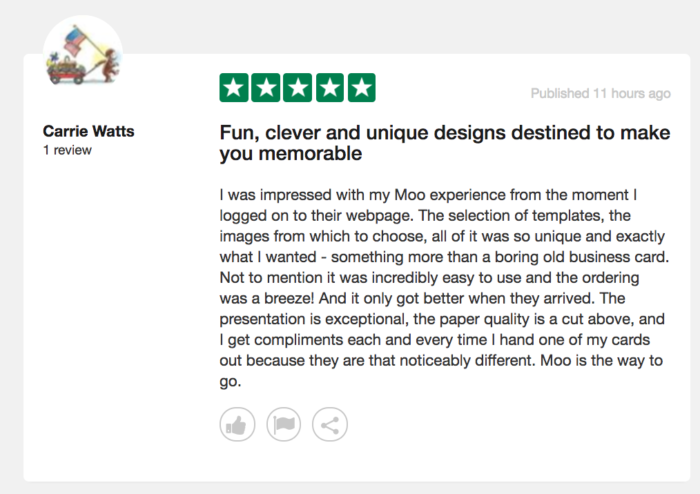
Or like Cards Against Humanity’s “horrible people” gush about them:

What do these brands have that you don’t? A voice their customers want to hear.
You can have that kind of voice too.
How to define your brand voice
Memorable ecommerce marketing and sales funnel copy starts by defining your voice.
Like “brand,” the concept of “voice” is hard to define. Put loosely, your voice is the impression your readers are left with after reading your copy.
(Copywriter Abbey Woodcock has a fantastic, free 39-page guide on finding your voice.)
Start by asking yourself these questions:
- Who do you want to BE to your readers?
- How do you want them to FEEL after reading your copy?
Maybe your brand identifies with a sensible, straightforward approach, like Everlane. Maybe it identifies with a more caustic or sarcastic bent, like Cards Against Humanity. Maybe your brand voice is eternally optimistic, like Zappos.
Voice is something you have to decide for yourself, and it needs to feel like a natural fit for your store. Otherwise, you’ll slip out of it too easily, and that’s bad when you’re trying to establish consistent branding.
Consistency in branding is just as important as branding itself. You have to brand yourself and your business in the same way, no matter where your brand or marketing materials appear.
Why? So people know you, recognize you immediately when they see your materials or read your copy, and even look forward to receiving your emails.
On a more scientific level, it’s been shown that people prefer risk over ambiguity. Plus, the type of relationship you cultivate with your customers can dictate how much ambiguity they’re willing to tolerate from you until they jump ship.
Translated to your ecommerce store, this concept means your customers might just risk trying out your competitor if you don’t clearly brand yourself.
Where to brand and where to back off
There are some particularly good spots in the ecommerce marketing and sales funnel to brand strongly. And then there are spots where you’re better off being straightforward, lest you inadvertently obscure your message.
So how do you decide where to play it straight and where to brand your copy?
In general, opt for clarity anywhere a purchase decision is directly involved. You can have a little more fun with all the surrounding copy.
Pretend you run Shiver Me Timbers, an online store that sells pirate costumes. A shopper is looking at a “wench” costume for Halloween. She puts the product in her cart, gets all the way to checkout, and then sees that the checkout button copy says something like “Arrr Ye Ready To Complete Yon Purchase?” instead of “Complete Purchase.”
A single moment of confusion can send shoppers scrambling for the tab “X,” leaving the store with an unidentified (and thus unsalvageable) abandoned cart.
So, if you’re ever in doubt, choose clear copy over branded copy.
Here’s what a consistently branded funnel looks like.
Old Spice brings its trademark absurd humor into its AdWords ads in subtle ways, imagining that readers can smell its videos, and keeping its emphasis at all times on “smelling good.”

It maintains the same branding and even the same wording in its copy (“Watch some nonsense,”) after clicking through.

And, when I get to an individual product description, customers are rewarded with even more absurdity:
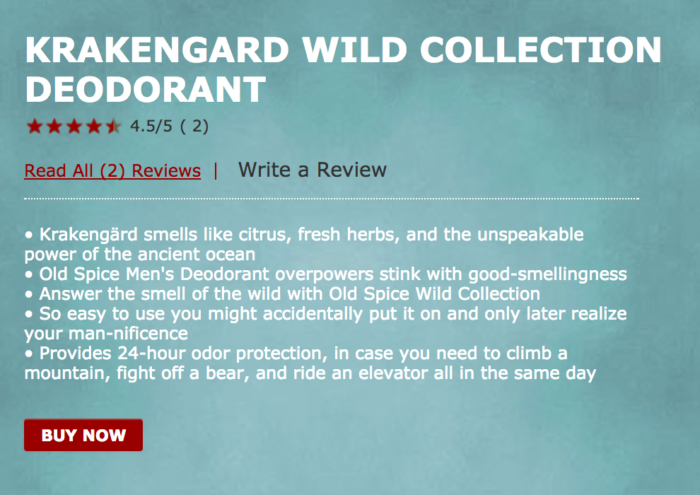
Inconsistent branding in your ecommerce marketing and sales funnel copy is a huge missed opportunity to market and make more sales.
Consistency in branding builds trust. It immediately helps you understand that you’re communicating with who you think you’re communicating with.
You’re not a prisoner to your brand.
Now, being cohesive and consistent doesn’t mean you’ve got to lock yourself into one voice forever. Everything gets stale without variety.
There’s room for flexibility in your branding and copy, just like there should be room for flexibility in your growth strategy and product line.
Your brand can earn itself the opportunity to mix it up without explanation. Look at Arena Flowers, which has garnered 33,000 Twitter followers for gleefully absurd tweets like this:
But, when you click through to the florist’s website, the copy is fairly standard. The company even waxes a little bit poetic in its emotional, bottom-homepage “About” blurb.
This is such a pronounced disconnect that it has to be intentional. In my charitable estimation, Arena Flowers knows what it’s doing: attracting a ton of media attention that in turn boosts its business. Know any other flower shops standing out the same way?
The first thing you need to do when evaluating your ecommerce marketing and sales funnel copy is to map out every single spot in your funnel where you have copy—from your first CTA to your follow-up emails.
Sketch it out on the back of a napkin, use Lucidchart, whatever you prefer.
Then look at the copy and design you’ve created for each of these spots. This will give you an overview of which parts of the funnel are strongly branded and which are still using a given platform’s “Default Copy” and, thus, offer a huge opportunity for branding.
Now let’s go through how to write copy throughout your ecommerce marketing and sales funnel. We’ll start with cold traffic at the top, and slide all the way through successful purchase at the bottom.
The top of the funnel is all about getting attention. Whether you’re posting on social, running a PPC ad, or offering something free, you have barely a few seconds to catch your reader’s eye as he scrolls by.
So it makes sense that you need to spend effort on strongly branded copy at this point in the funnel.
Social media, content, and PPC ads all play a part in getting people to your store. Since ecommerce content offers are a different animal altogether, let’s focus on social media and PPC for now.
Social media
People love interacting with other people on social media. They don’t love interacting with brands, except to complain roughly 30% of the time.
When users do enjoy interacting with brands, the lucky brands tend to be those with a distinct voice, like Arby’s: brands that break the mold of dry corporate-speak and insincere public apologies and talk like real humans.
The Liger Shake: It's pretty much our favorite shake. It's like chocolate and orange mixed. pic.twitter.com/Q3GhitjA1W
— Arby's (@Arbys) June 8, 2017
“Pretty much” and “like” are way more casual phrases than you’ll find in the copy of most other international brands. (Arby’s calls its marketing approach “Putting Meats and Authenticity Front & Center,” by the way.)
Just for kicks, look at the tone of Cards Against Humanity’s interactions with its fans on Facebook:
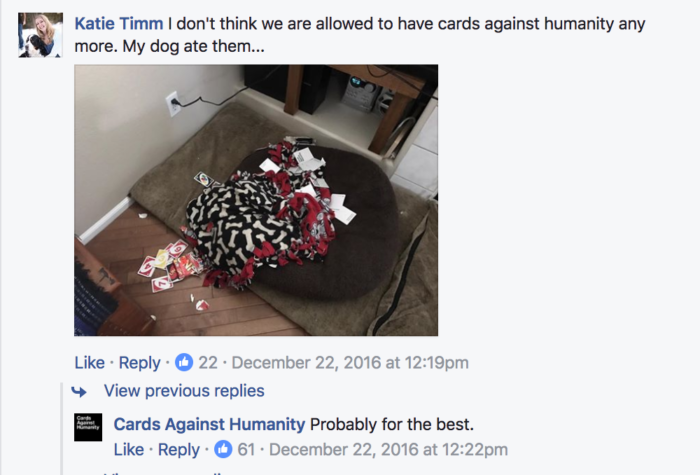
If your customers expect this type of voice from your brand, you can actually be sarcastic them, like CAH does, and STILL create crazed fans.
Takeaway Tip:
Your social media copy can be a huge source of attention (and revenue-generating traffic). But only if you base everything you write, from the words you use to the length of your sentences, on your knowledge of your customers.
Along with swiping words from your customer surveys, polls, etc, look at the tone of your interactions with existing customers.
Paid traffic
Writing PPC ads is a specialty of many copywriters, but many of the same rules of good copy apply, like meeting your prospect where they are.
Different prospects will have different levels of knowledge of your existence and your product. To be most effective, your copy should meet users at their current state of awareness (this is where you’ll return to your user research, which will tell you your prospect’s state of awareness).
Johnathan Dane, PPC Overlord, notes that, if your target searches for “How to get rid of acne,” your ad shouldn’t ask if they’re “Dealing with acne”—because you already know they are.
- Step one: Build on what your searchers’ keywords are telling you.
- Step two: Once you’ve dialed in your target’s state of awareness, it’s time to make sure your copy stays in tune with your voice and stands out from the crowd.
Consider the following examples. Here are a few quick screenshots of AdWords ads from copywriters for hire (omitting ads by content mills and freelancing job boards).
They all look the same:
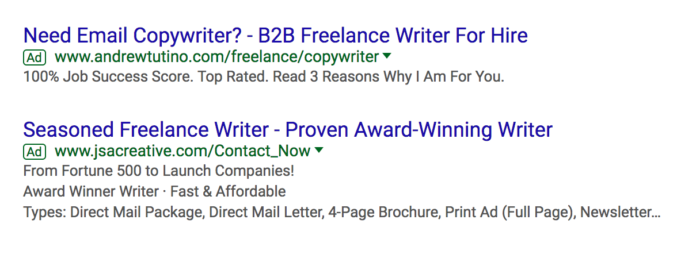
By contrast, here’s copywriter, Hugh Gurin, standing out by directly addressing people who search for copy-related keywords:

Hugh’s tone stays direct and to the point, but it’s still conversational. It also does away with the title-case convention that may improve PPC click-through rates, in some cases, but can dismayingly state, “Hello, I Am An Ad!”
It’s important to remember that PPC ads are more customizable than ever, so make sure you’re taking full advantage of the device or platform your prospect is using. Specificity can really help you stand out here.
Using specifics in your copy—whether it’s the percentage of doctors who recommend “x solution,” scientific facts, the number of happy customers currently using your product, or a description of the exact type of customer who’ll benefit from your product—makes you more believable.
Specificity also posits you as a trustworthy authority who seems like she knows what she’s talking about.
Consider the difference between these CTAs: “Shop now” and “Shop right from your Android.” Which would you be more likely to click? Which seems like it would probably be an easier experience if you were using an Android?
Takeaway Tip:
Make sure your copy matches your target’s state of awareness. Then make your ad copy stand out by being more conversational and specific. Speak right to the prospect.
In many business models, the middle of the funnel is the “education” stage. It’s where you focus on giving value, showing your prospect you understand their problem, and showing why you’re the best option to solve their problem.
As it pertains to ecommerce, the middle of the funnel is when your prospect has clicked through some top-of-the-funnel copy or content, and is now browsing your site.
You’ve got lots of opportunities to brand your onsite copy:
Onsite copy and offers
When they’re on your store website, your prospect is a hair’s width away from converting. So be very careful to strike that balance between strongly branded copy and clear, conversion-focused copy.
Luckily, it’s entirely possible to align your branded copy with your conversion goals, even in smaller on-site copy like banners and footer copy.
Take a look at how Everlane accomplishes the perfect balance in this site-wide banner offering free shipping:

Like Everlane’s copy across its whole funnel, this is subtle and no-nonsense, so it’s definitely on brand.
And yet it’s addressing me directly with the word “you,” tempting me with an offer, and making me feel a sense of urgency through use of the word “currently,” so it’s conversion oriented.
Here’s Madewell taking advantage of its website footer copy (an oft-neglected spot):

This copy is warm, friendly, and specific, so it’s on brand.
It also tells me exactly how to get help and includes links, so it’s conversion oriented.
Takeaway Tip:
Don’t overlook any copy on your site, even if you think no one will read it (like the footer copy). Test straightforward language against more brand-heavy phrasing and see if a pattern emerges among the winning variations.
Category page copy
Your category page copy should be short and sweet. Reinforce why people are here and let them get where they want to go. Quickly.
Here’s a great category page example from DiBruno Brothers:
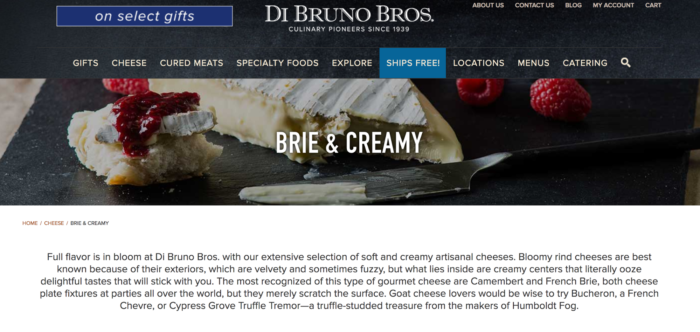
This category page copy is doing three great things:
- Reinforcing that I’m in the right place (I clicked the “Brie & Creamy” category)
- Making me salivate with specifics: “soft, creamy centers, ooze,” etc.
- Suggesting related products I’ll enjoy
The copy is also using this opportunity to educate me on “bloomy rind cheeses,” which reinforces that DiBruno knows what it’s talking about when it comes to cheese, and makes me consider the brand an authority.
Takeaway Tip:
Add a little bit of copy to your category pages, and use it as an opportunity to reinforce your authority.
Product description copy
You’re here to sell products, and what you have to say about those products is crucial to your discerning visitors.
Keep the following three product description copywriting rules in mind:
Rule #1: Never use the manufacturer’s description.
Writing your own copy, even if you’re just rewording the description that came with the product, automatically levels you up above Amazon and many other retailers who wholesale products. Plus, it’s better for your SEO.
Rule #2: Put the product in context. Show how your reader will use it. Make them touch it, smell it, taste it, feel it in their hands. Tell them about the materials it’s made with, how it compares to similar options, and how it’s superior.
Here’s an example from athletic apparel-maker Girlfriend Collective, which uses its product copy space to tell you exactly how to use or wear this sports bra:

For more about how to make your product tangible and put it in context, check out my guide on how to write conversion-oriented product descriptions.
Rule #3: Your products are part of your brand, so brand your product copy.
Think back to the voice you’ve created for your brand identity. The voice you used to write irresistible top-of-funnel copy. The voice that informs how you (a person) actually communicate with your customers (other people).
Now ask yourself: how can I filter the product information my customers need through my brand voice? How can I present the very same information in a silly, sarcastic, sensible, or warm way?
Here’s soapmaker Somewhat Organic showing off its wacky personality on its About page:

The soapmakers follow through with the same voice in their product descriptions—while still providing all the info on ingredients that their prospects are looking for.
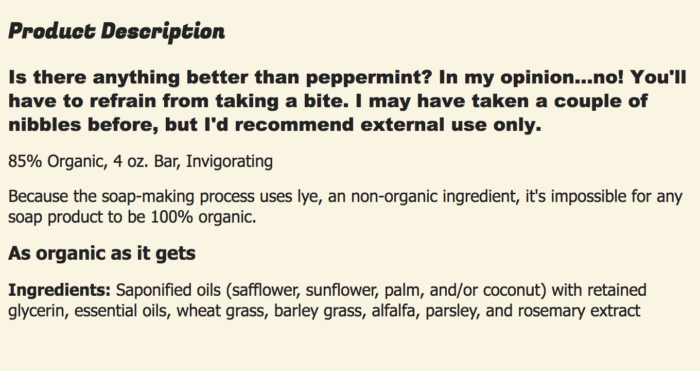
Takeaway Tip:
Boost your branding in your product descriptions by filtering need-to-know info through the same voice you use in your top-of-funnel copy.
We’ve made it all the way to the bottom of your funnel. Now let’s check out the copy surrounding the ecommerce checkout.
(Your checkout process may differ from the below slightly, especially if you only sell one product or you include additional checkout screens, but it likely includes the same funnel points.)
Add to cart copy
Once your prospect is on the product page, she has the chance to add the product to her cart. This is a crucial moment.
This is another of those points where it’s more important to be clear than clever. Remember that imaginary pirate costume shopper earlier who flaked when she saw that the “Complete purchase” button said “Arrrr Ye Ready?”
Don’t try to brand this button copy unless you really know what you’re doing and you’re 100% sure that you won’t be adding doubt or confusion into the checkout process.
Cart review/checkout copy
Now your user has added a product to her cart, and she’s ready to check out. What should you show her? What kind of microcopy will serve you best here—and should it be strongly branded?
Here’s Dropps seeking normal inputs like discount codes and account info on its checkout screen. But notice that it’s phrasing everything as a question, like so:
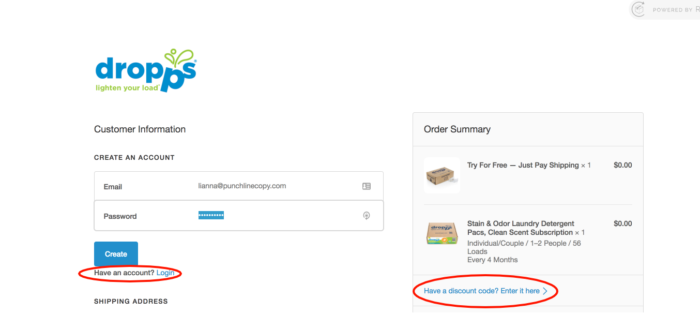
It’s subtle, but this shows forethought and care on the part of the marketing team. It feels sweeter and more personal than “Log in with existing account” or “Enter discount code.”
Takeaway Tip:
Your microcopy is full of opportunities.
Don’t forget to run an exit-intent poll to try to find out why users are ditching you. Soften the ask by phrasing it this way: “Before you go, could you tell us what went wrong?” or “Sorry to see you go! Would you let us know what was missing?” Ask like a human and other humans will give you valuable insight.
Thanks/confirmation page copy
If your prospect completes a purchase with you, why would you respond with a purchase confirmation page that looks like an invoice from a funeral home?
It’s okay to share your users’ feelings of excitement and accomplishment with them as they complete their purchase. It’s not okay to make them feel that, as soon as they click “Complete purchase,” they become nothing more than an order number to you.
Email receipt/order confirmation copy
Look at this well-done purchase confirmation email from beauty brand Glossier:
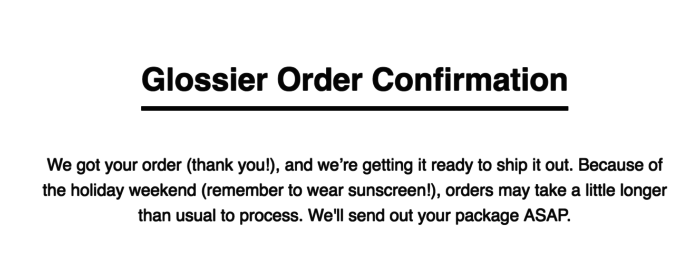
The parentheticals in this copy make it feel casual, while the reminder to wear sunscreen is very on brand for a beauty company.
Shipping notification email copy
It’s a good idea to let buyers know when their items have shipped, and the shipping confirmation is yet another opportunity to brand what’s otherwise a boring, ignorable email.
Turn that humdrum template copy into a truly delightful experience, like razor company Harry’s:
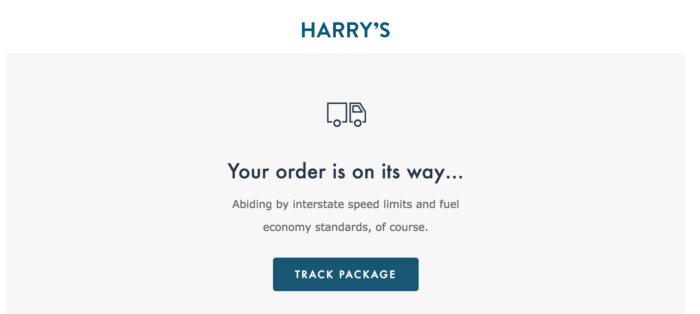
This shipping copy is funny, it’s to the point, and it reminds the user that they bought something and that it’ll arrive soon.
Whether it’s the time between a customer’s first touch and the day they buy, or the few days between their purchase and the day they receive their item, you can take advantage of that transitional time with well-written copy based on whether they made a purchase or not.
Option A: They purchased from you.
Your customer purchased from you. Now what?
Now you keep that customer engaged in the time that elapses between the moment of purchase and when their shipment actually arrives.
You can maintain your customer’s interest and build your relationship with them in the interim. All you have to do is avoid totally abdicating your duties to your retention copy.
Here are some ways to take advantage of copy opportunities in your post-purchase customer interactions:
1. Send customers value or educate them.
Cat litter startup PrettyLitter sends follow-up emails with the same friendly yet non-prescriptive voice as its website copy. This is the perfect voice for PrettyLitter users, with whom the company shares a love of cats and a desire to keep them healthy, but not a veterinary degree.
Here’s PrettyLitter sending advice on how best to use its product while the product is being shipped:
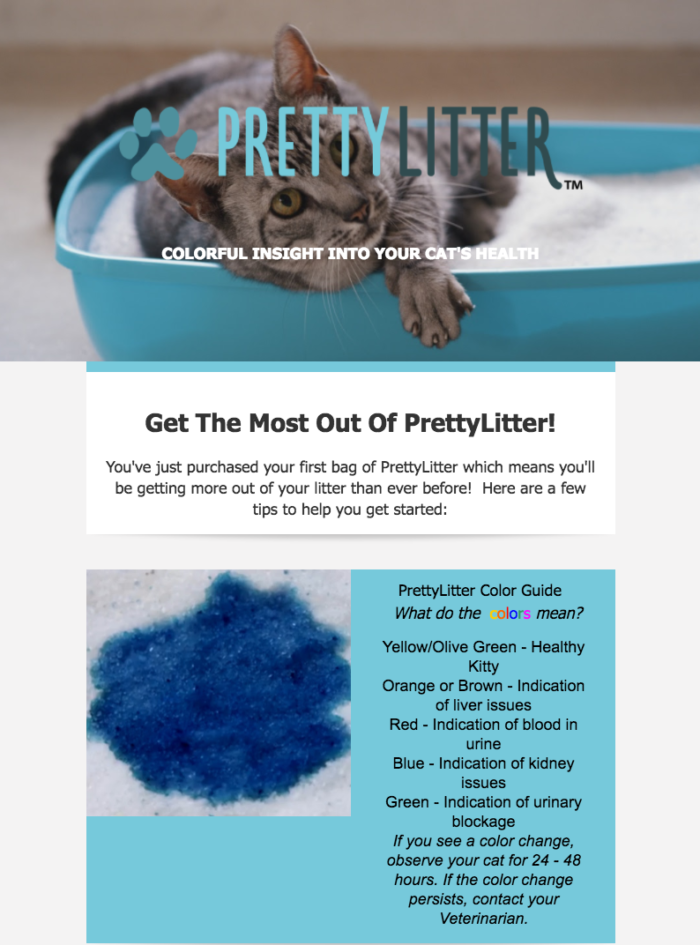
2. Follow up about the purchase experience.
You want to know every little detail about your customer’s experience, so you can improve that experience in the future. One little way to get those details is to send a post-purchase email survey.
There’s a lot out there about the best way to write survey emails for ecommerce, but let’s look at one quick example from eyeglass seller Warby Parker:
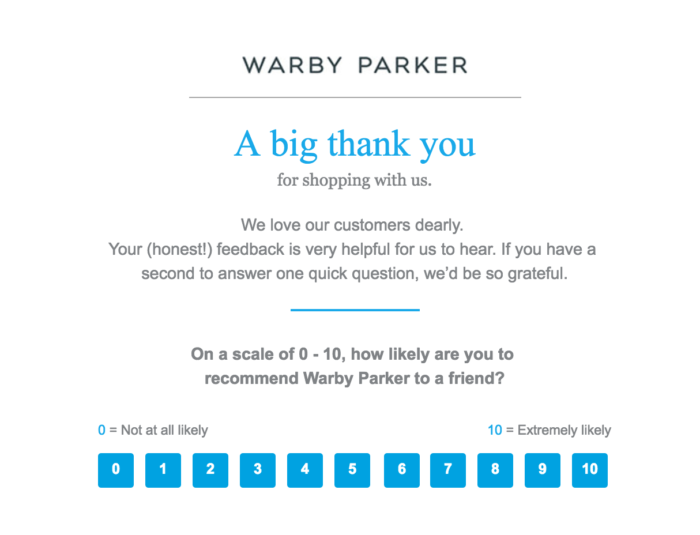
Like the rest of Warby Parker’s branding, this email is written in a chipper, plainspoken, and gratitude-filled style.
And, once I finished the survey, I was treated to this surprise:
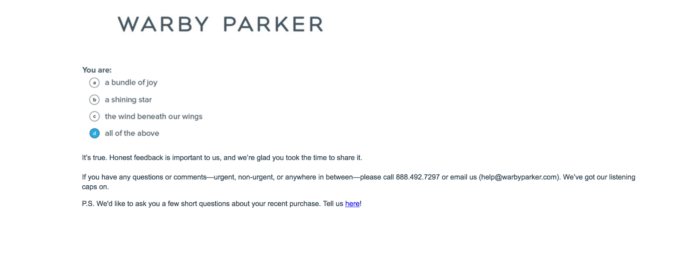
3. Celebrate a birthday or purchase anniversary.
Sending a “happy birthday” email with a coupon code is a nice treat, and you just might catch a customer on the perfect day when they feel like treating themselves.
You can send this message on the customer’s birthday, or even on your own birthday or store-opening anniversary, like Etsy textile-jewelry maker birdienumnum:
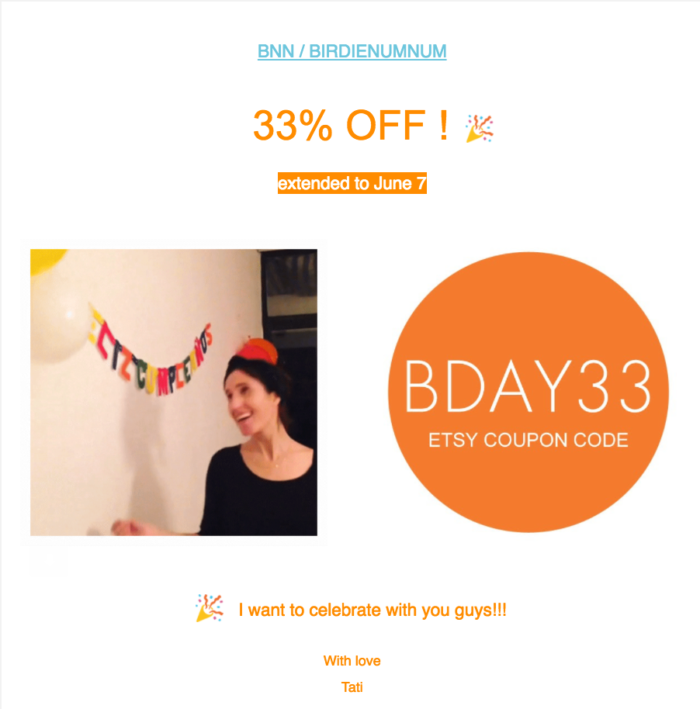
You can also send on the customer’s first purchase anniversary, like ModCloth:
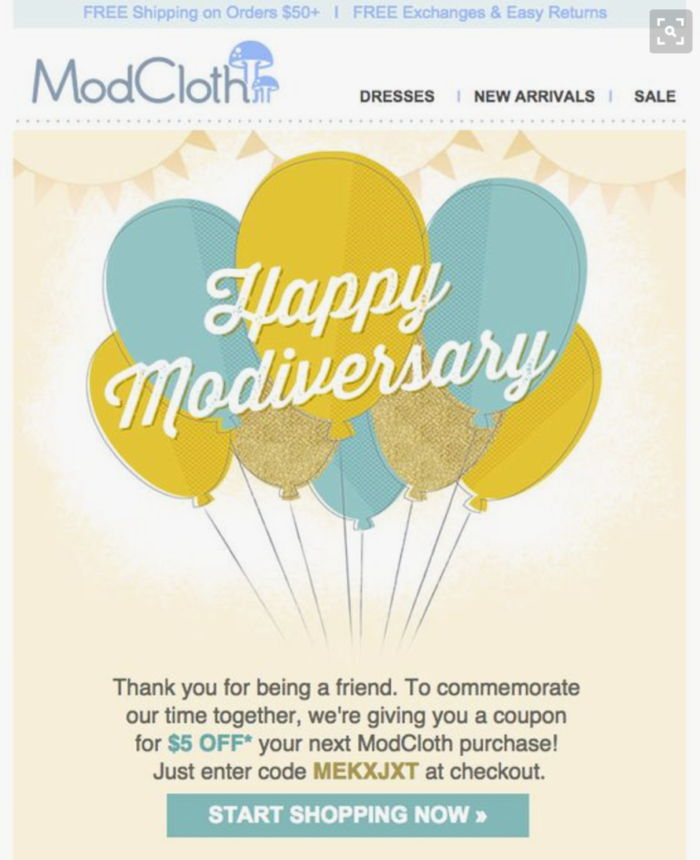
Notice how both of these emails take a celebratory and grateful tone. They make an ask, but not before offering something first. They’re playful and lighthearted and use words like “commemorate” and “friend.”
The copy is what makes these emails work.
4. Invite them to a membership program.
People like being part of exclusive clubs. If you play your copy cards right, you can make your membership or loyalty program seem like an exclusive club, while building a relationship with your customer.
Here’s Zappos doing it right with cheerful copy and a tempting incentive:
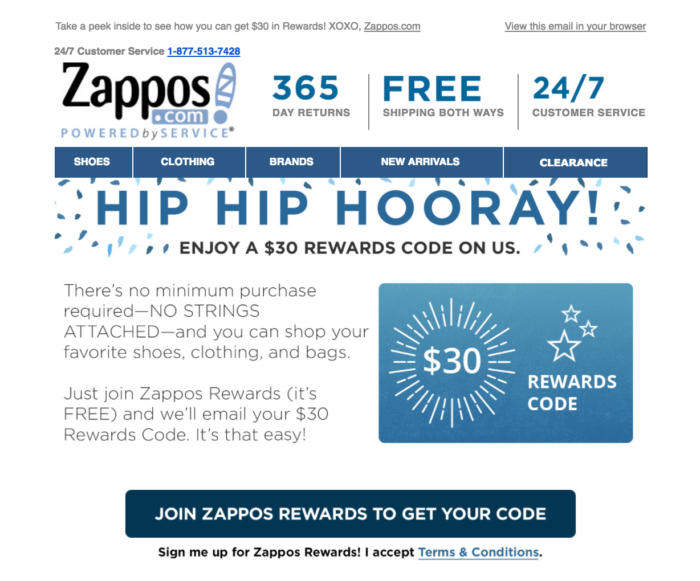
Option B: They did not make a purchase.
In the sadder version of this story, your customer bounced without buying. But don’t worry. There’s still hope to win them over.
1. Abandoned cart emails
Suppose prospect Polly is shopping at your ecommerce store. She adds an item she loves to her cart. Then she gets distracted and ends up closing the tab.
If Polly were logged into her account at your store when she left—or even if she only got a little bit of the way through registering for an account—you could send her an abandoned cart email.
Sending a simple reminder that a prospect has left behind an item they wanted can convince them to come back, to the tune of potentially hundreds of thousands more sales per year.
Everlane’s abandoned cart email, like all of its branding is subtle and subdued. Subject line: “Eyeing Something?”

I especially love the low-pressure “Take Another Look” CTA copy.
Chubbies takes a vastly different, but equally well-branded tack in its abandoned cart email copy:

2. In-stock notifications
Considering that out-of-stock items can cost sellers dearly, you should be paying close attention to the effectiveness of your restock notifications and emails.
If your customer has indicated interest in an out-of-stock product by adding it to a wishlist or requesting to be notified when it’s back in stock, make it your business to make the copy in those restock notifications utterly irresistible.
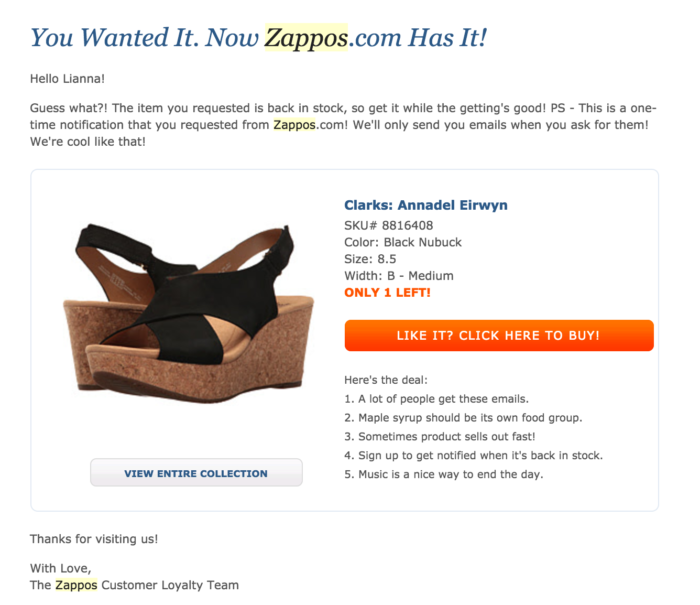
The copy in this email is so upbeat, with lots of exclamations, and short sentences. Casual phrases like “Guess what?!” and “while the getting’s good” and “cool” make this copy super-friendly and relatable.
It also reminds me that I asked for this email. And, finally, it’s signed personally by the Zappos team, which makes me feel like they actually sent it to me, instead of a robot sending it to me by default.
3. Retargeting Ads
The same copy principles you’ll use in your PPC ads apply here. Except now you have the added benefit of knowing exactly what your user wants.
Show that item to them in your retargeted ads. Then stand out by making sure your ad speaks in your voice. Many ecommerce businesses never take the second step.
It’s easy to retarget your prospects by simply showing them the products they looked at (a technology called dynamic remarketing). That’s what Catbird, a New York boutique, has been doing to me ever since this afternoon, when I considered referencing one of their perfumes in this article.

But it’s trickier—and potentially more rewarding—to think carefully about the copy you use in your retargeting ads.
Here’s skincare brand Deciem retargeting me on Instagram:
View this post on InstagramA post shared by The Ordinary, NIOD, & more. (@deciem) on
Deciem has branded itself as a dry-witted, no-nonsense beauty company (because its low-priced products are comparable to those sold by much more expensive beauty retailers). So it makes sense that they crack a non-sequitur at the very start of their retargeting ad copy, and then move on to explain the benefits of a new product they’re selling.
Wrap up
Your users should be able to recognize your brand and copy anywhere, even when they’re away from your store.
This is a function of design and message-matching as much as it’s a function of copy, but copy has a surprising amount to do with it.
Pay close attention to branding your copy throughout your funnel, making sure it’s based on customer research, full of specifics, and clear. Never use default copy without customizing it to your brand’s voice. And don’t be afraid to try something different in your copy. You might just strike gold.
This post was originally published in July 2017, and was updated in May 2020.